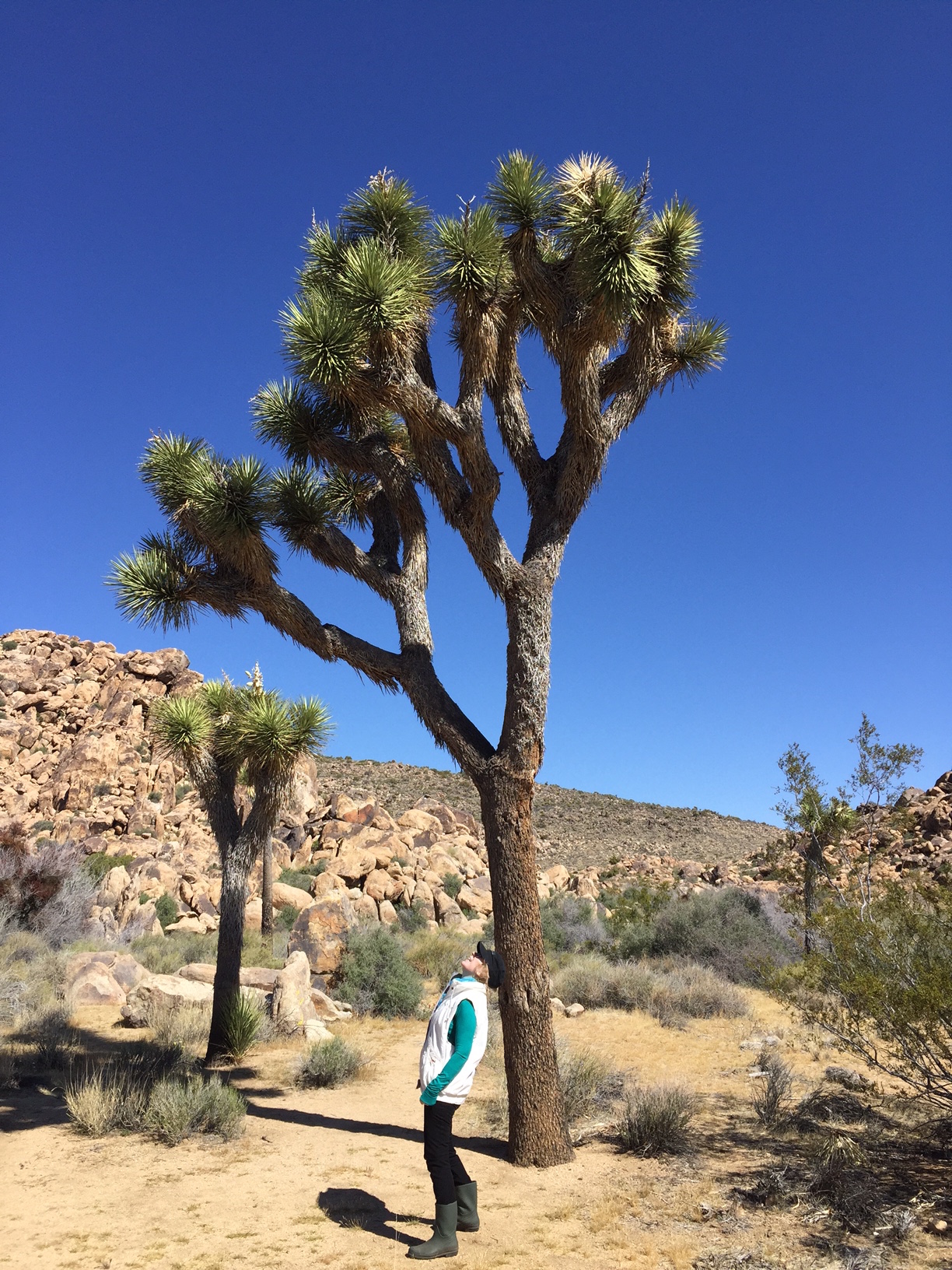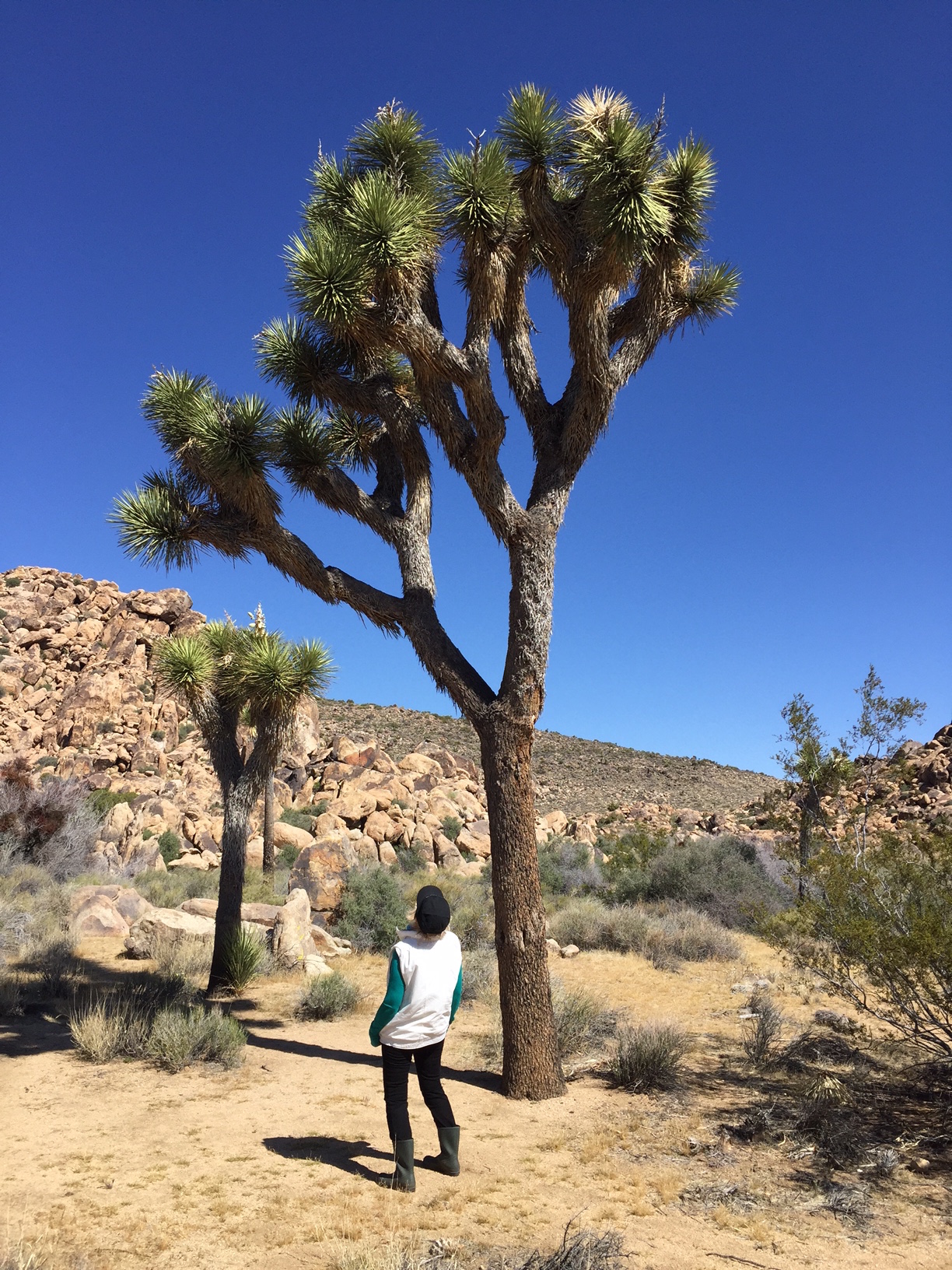After a 2,000-mile drive from Michigan in our ‘95 van, we finally entered California, eventually to wind up in Pasadena where our extended family lived.
But first- Joshua Tree National Park beckoned. Planning our route, this park’s name caught our attention. What sort of tree was that? The botanist in me was intrigued.
We arrived there in late afternoon and booked a room at Motel 6, (which accepts pets). This little town describes itself as ‘The gateway to the Joshua Tree National Park.’
Perfect.
Our room was fine, and so was the weather. Oh, we’d been lucky in that regard!
First thing the next morning, after bracing cups of coffee and two sides of bacon, we gathered Bryn and drove for about 5 miles down a paved two-lane road, then turned into the Visitors Center, just before the park’s entrance. Rangers were full of information about the park’s charms, but they also warned us: Don’t wander off trail or leave park roads; it’s very easy to get disoriented, and even easier to die of thirst. 500,000 acres of this 800,000-acre Mohave Desert park are wilderness.
Some sobering facts: There are a shocking number of people, including children, who have gone out there to explore, and have never been found.
One woman, finally located inside her car, was near death, but survived. Her child though, died in the summer’s 125 degree heat. Never mind that this is high desert. It Gets Hot.
She, like so many others, had depended on her GPS to guide her to interesting ruins.
**Fact: GPS is quite unreliable in this remote spot. It will cheerfully send a naïve visitor, who often carries an inadequate supply of water, off to oblivion. Her SUV had gotten stuck in the sand, well off the road, probably guided there by her addled GPS.
Two science graduate students out for a drive and a hike, vanished in 2012. Their bones were found by accident in the deep desert half a year later. They’d also trusted their car’s GPS.
We appreciated the advice, and were glad it was April: temperatures don’t usually exceed the low 80s in the afternoons. We’d park at designated laybys, and explore close to our vehicle. Bryn wasn’t allowed anywhere a car couldn’t drive. So that limited us, but we didn’t mind. The scenery was spectacular everywhere.
(Note: Bryn, Joe and I kept getting really fatigued much sooner than normal. I put it down to sitting in the van for days, as we traveled through this huge continent. But that wasn’t the whole story. All the parks are at high altitudes- often over 4,000 feet.. Those not acclimated to the much thinner air do tire quickly. (At least a week or two of ‘living the high life’ is necessary, to better acclimate.)
Joshua Trees- actually part of the yucca family- were everywhere! They’re happiest growing at altitudes between 1,500 and 6,000 feet in full desert sun. They have no growth rings, so it’s hard to tell their ages. They might live up to a thousand years. In the first few, though, growth is more rapid- about three inches a year. Then they settle down to rise about an inch a year. The tree’s shallow root system can extend nearly 40 feet from the trunk.
These peculiar trees were named by passing Mormon settlers, who thought the spreading branches looked like Joshua’s as he raised them to heaven.
We visited Skull Rock, a giant, smooth boulder set among many more, that looked like a human skull, and saw the Cholla cactus forest. These attractive little plants are lovely when in bloom, and remind some people, especially children, of cuddly teddy bears. But to touch one means pain! Those long thorns need just a suggestion of a caress to imbed themselves deeply in human flesh. So, admire from a respectful distance, and move on...
We checked out the Hall of Horrors, a group of massive boulders that rise straight up in a pattern that is challenging to climb. Tumbles aren’t rare. Neither are broken bones.
As with all desert parks, poisonous snakes are out, especially in the heat of the day. It’s always best to watch where one walks.
Bryn was fascinated by the desert and its scents, and took deep breaths to absorb them, which resulted in some impressive sneezes.
We hiked a bit up and down the sand-blown road, which was empty of cars this early in the season, and took lots of photos of the trees and topography. A few Joshuas were nearly 40 feet high, their odd, impressive branches capped with those peculiar yucca ‘leaves.’ The general effect is suggestive of a Dr. Seuss forest.
This amazing place has a savior. Minerva Hamilton Hoyt, born in 1866 on a plantation in Mississippi to an upper class family, was a passionate Pasadena gardener who loved Joshua trees. Understanding their rarity and special needs, she worried that they would continue to be used for target practice by indifferent, bored hunters. She haunted the halls of Congress trying to get that unique area set aside as a park. Finally, in 1936, after decades of tireless work, she convinced Roosevelt to establish the Joshua Tree area as a National Monument. Then, on Halloween in 1994, its almost 800,000 acres were elevated to National Park status!
I so wish Mrs. Hoyt could have lived to see it happen.
Finally, it’s forever safe.







